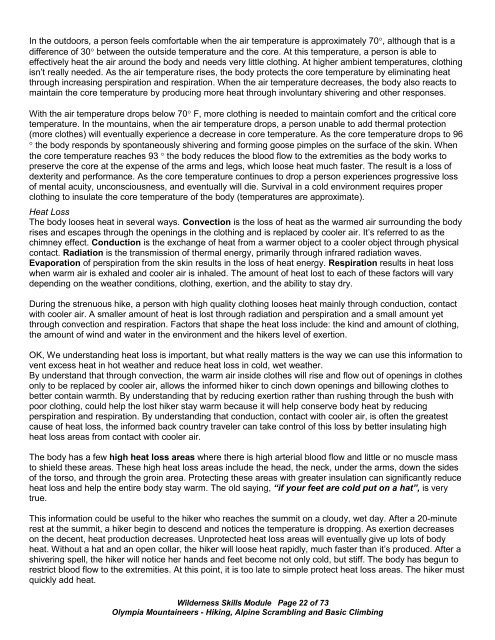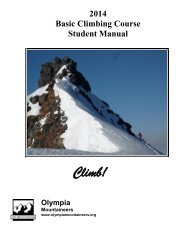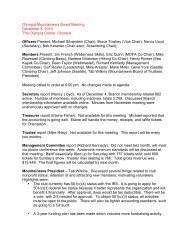Wilderness Skills - Olympia Mountaineers
Wilderness Skills - Olympia Mountaineers
Wilderness Skills - Olympia Mountaineers
You also want an ePaper? Increase the reach of your titles
YUMPU automatically turns print PDFs into web optimized ePapers that Google loves.
In the outdoors, a person feels comfortable when the air temperature is approximately 70°, although that is a<br />
difference of 30° between the outside temperature and the core. At this temperature, a person is able to<br />
effectively heat the air around the body and needs very little clothing. At higher ambient temperatures, clothing<br />
isn’t really needed. As the air temperature rises, the body protects the core temperature by eliminating heat<br />
through increasing perspiration and respiration. When the air temperature decreases, the body also reacts to<br />
maintain the core temperature by producing more heat through involuntary shivering and other responses.<br />
With the air temperature drops below 70° F, more clothing is needed to maintain comfort and the critical core<br />
temperature. In the mountains, when the air temperature drops, a person unable to add thermal protection<br />
(more clothes) will eventually experience a decrease in core temperature. As the core temperature drops to 96<br />
° the body responds by spontaneously shivering and forming goose pimples on the surface of the skin. When<br />
the core temperature reaches 93 ° the body reduces the blood flow to the extremities as the body works to<br />
preserve the core at the expense of the arms and legs, which loose heat much faster. The result is a loss of<br />
dexterity and performance. As the core temperature continues to drop a person experiences progressive loss<br />
of mental acuity, unconsciousness, and eventually will die. Survival in a cold environment requires proper<br />
clothing to insulate the core temperature of the body (temperatures are approximate).<br />
Heat Loss<br />
The body looses heat in several ways. Convection is the loss of heat as the warmed air surrounding the body<br />
rises and escapes through the openings in the clothing and is replaced by cooler air. It’s referred to as the<br />
chimney effect. Conduction is the exchange of heat from a warmer object to a cooler object through physical<br />
contact. Radiation is the transmission of thermal energy, primarily through infrared radiation waves.<br />
Evaporation of perspiration from the skin results in the loss of heat energy. Respiration results in heat loss<br />
when warm air is exhaled and cooler air is inhaled. The amount of heat lost to each of these factors will vary<br />
depending on the weather conditions, clothing, exertion, and the ability to stay dry.<br />
During the strenuous hike, a person with high quality clothing looses heat mainly through conduction, contact<br />
with cooler air. A smaller amount of heat is lost through radiation and perspiration and a small amount yet<br />
through convection and respiration. Factors that shape the heat loss include: the kind and amount of clothing,<br />
the amount of wind and water in the environment and the hikers level of exertion.<br />
OK, We understanding heat loss is important, but what really matters is the way we can use this information to<br />
vent excess heat in hot weather and reduce heat loss in cold, wet weather.<br />
By understand that through convection, the warm air inside clothes will rise and flow out of openings in clothes<br />
only to be replaced by cooler air, allows the informed hiker to cinch down openings and billowing clothes to<br />
better contain warmth. By understanding that by reducing exertion rather than rushing through the bush with<br />
poor clothing, could help the lost hiker stay warm because it will help conserve body heat by reducing<br />
perspiration and respiration. By understanding that conduction, contact with cooler air, is often the greatest<br />
cause of heat loss, the informed back country traveler can take control of this loss by better insulating high<br />
heat loss areas from contact with cooler air.<br />
The body has a few high heat loss areas where there is high arterial blood flow and little or no muscle mass<br />
to shield these areas. These high heat loss areas include the head, the neck, under the arms, down the sides<br />
of the torso, and through the groin area. Protecting these areas with greater insulation can significantly reduce<br />
heat loss and help the entire body stay warm. The old saying, “if your feet are cold put on a hat”, is very<br />
true.<br />
This information could be useful to the hiker who reaches the summit on a cloudy, wet day. After a 20-minute<br />
rest at the summit, a hiker begin to descend and notices the temperature is dropping. As exertion decreases<br />
on the decent, heat production decreases. Unprotected heat loss areas will eventually give up lots of body<br />
heat. Without a hat and an open collar, the hiker will loose heat rapidly, much faster than it’s produced. After a<br />
shivering spell, the hiker will notice her hands and feet become not only cold, but stiff. The body has begun to<br />
restrict blood flow to the extremities. At this point, it is too late to simple protect heat loss areas. The hiker must<br />
quickly add heat.<br />
<strong>Wilderness</strong> <strong>Skills</strong> Module Page 22 of 73<br />
<strong>Olympia</strong> <strong>Mountaineers</strong> - Hiking, Alpine Scrambling and Basic Climbing




